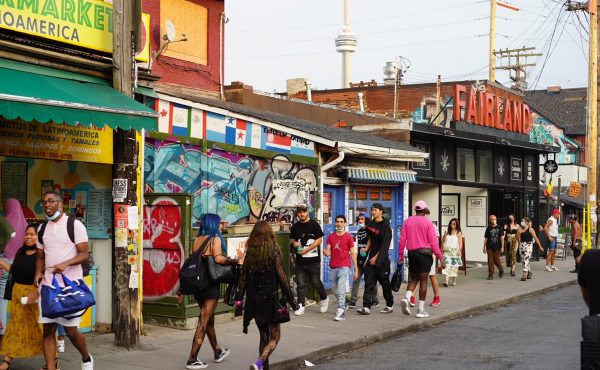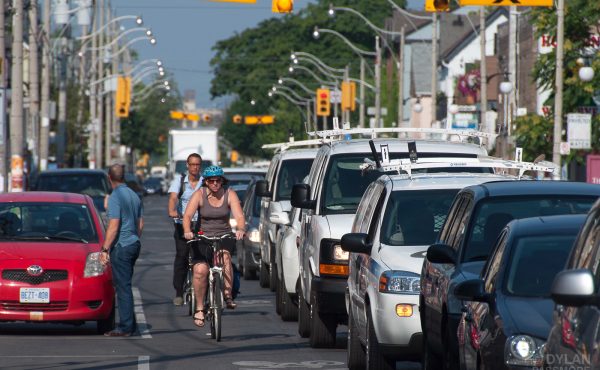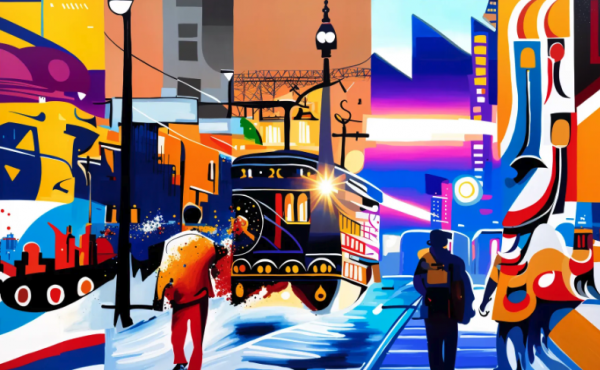
Last fall, I took part in a walkabout along and around John Street with an urban planner who was working on a master plan for the Entertainment District on behalf of the local Business Improvement Association (BIA). Lots of good ideas for the area were discussed, but the most interesting concept was the idea of making John St. into an attractive, pedestrian-oriented “shared street”, in the style of an increasing number of downtown streets in European cities and even some in North America, transforming it into a real destination that could serve as the heart of the district, and a place where artistic installations and a variety of events could be staged.
The idea of a shared street is to create a distinctive space where motor vehicles are made aware that they share the roadway with cyclists and pedestrians. As a result, motor vehicles drive slowly, and the volume of motor vehicle traffic is low (because other routes are faster), creating a safe and comfortable venue for cyclists and a space where pedestrians can overflow from crowded sidewalks or cross easily at any point. It should be designed so that everyone knows to watch out for and accommodate each other.
John Street makes a lot of sense for this concept. It is not a major route for cars, who have plenty of alternatives (such as Simcoe, Duncan and Peter). It’s currently pretty nondescript, but it connects a series of very pedestrian-oriented streets (Queen, King) and destinations, especially a whole series of high and popular cultural sites: from the AGO at the top, through MuchMusic (which often closes it for various events already), the National Film Board and the Scotiabank movie theatre, the club district’s clubs and restaurants, the live theatres and restaurants on King, the Film Festival’s new Lightbox movie theatres, Metro Hall, the CBC headquarters with the Glenn Gould theatre, and finally the Convention Centre, the Skydome and the CN Tower. There is also quite a spectacular potential view of the street north from the bridge over the tracks at the Skydome, although at the moment it’s not much to look at.
Not surprisingly given these destinations, the majority of the trips on the street are made on foot (PDF) — over 60% at most times of the day, and never less than 49%. That’s the case even now when it is simply a functional street, with mostly standard, uninteresting sidewalks and little to attract people unless they need to use it. Effectively, even without much of interest, it already serves as the connecting corridor of the entertainment district and the various cultural, visitor and employment destinations along it.
If it were transformed into an attractive space, a “cultural corridor” with a real sense of place that was open to special events and installations, it could become an appealing destination that provides the district with a connecting spine the area doesn’t quite have a the moment. The number of people walking there would increase significantly.
With the support of the BIA, the City of Toronto is currently conducting a study of the possibilities for John Street. They’ve looked at various alternatives (PDF), but while they consider the idea of a shared street (“alternative 2”), City staff have unfortunately backed away from it and instead are advocating a more conventional plan to just widen the sidewalks (“alternative 4” — the road would be reduced to one lane in each direction that would be wide enough for safe cycling — especially since there is no parking).
The study cites “safety challenges” as one drawback of the shared street idea. While it’s natural to be concerned about this issue, shared streets have been implemented safely in many places. Part of the concept is creating ways to signal to vehicles that the nature of the street is different and that drivers should proceed slowly and cautiously, through varied paving and other signals — strategies that have proved effective elsewhere.
Another reason the study doesn’t embrace the shared street alternative is the nature of the evaluation process. If you look closely at the City’s evaluation criteria (page 6 of this PDF), the “socio-cultural” category seems to in fact focus on the impact on local businesses (while the “economic” category is about the cost to the city). That means that one of the real strengths of the shared street idea — to create a great space for social and cultural activities — is essentially overlooked.
The impact on business should be considered separately — but even then, it’s not clear why the shared street concept would be a problem, since it’s the local BIA that has been supporting the idea.
The preferred alternative is certainly not bad — it would make for a much more attractive street that would gain a “sense of place” that it currently lacks and become something of a destination. But it reduces the potential for a truly inspiring and innovative transformation. As well, without a clear plan for slowing vehicle traffic, it’s not as clear that it benefits cyclists all that much (although a single wider lane in the southern part of the street will help a bit and may reduce traffic volume).
On the plus side, the preferred alternative sets the stage for a potential evolution of the street going forward. As the street becomes more heavily used by pedestrians and as more events are held there, the desirability of a shared street may become more evident, and additional steps can be gradually taken to move in that direction.
photo by Bryson Gilbert




10 comments
The recommended or shared street alternatives work for me.
Certainly more room for pedestrians and a grand beautification will encourage ‘active transportation’ and add to the public realm in a profound way.
I am rather discouraged to see the bike union opposing this in favour of bike lanes yet again.
They ruined the Jarvis street proposal (it will remain ugly and unfriendly to pedestrians); and now they want a bike lane again where not proposed by the bike plan and were it is frankly unnecessary.
The proposal they have for bike lanes will not come at the expense of drivers, but rather walkers.
Could they not get behind the long-standing proposals for bikes lanes on both Peter/Blue Jays Way and Simcoe (Queen to Front) instead?
Sigh
Kevin, I understand your concern or frustration with the bike lobby, but let me clarify one thing. The Jarvis streetscape project went from its original proposal to the current plan because of the time it takes to do environmental assessments. The original plan required narrowing the paved area of the street and widening sidewalks. This would require a provincial and federal EA because the ‘slope’ of the road had to be addressed. The current plan is nothing more than paint and only requires a municipal EA. The municipal EA only takes a couple months; provincial and federal takes years…years beyond this fall’s election when it’s assumed that no change would happen to Jarvis.
Hey Kevin,
John Street is wide enough to accommodate both wider sidewalks AND a bike lane. There does not have to be any ‘or’ in this case (as there was with Jarvis).
As for Simcoe: Yes, of course the ‘bike lobby’ (concerned cyclists looking out for their own safety) would get behind bike lanes on Simcoe. But there is no plan on the table to re-design Simcoe. The plan is focused on John, so we’re looking at John.
Also, Simcoe and Peter both have difficulties in terms of connecting them smoothly with the Beverly lane. John St is the best choice for bike lanes in that area.
As for the “Bike Plan”, personally I think it’s a rather pathetic document that provides a bare-bones network. Cyclists want to see way more bikelanes than the ones outlined in the 2001 proposal. Every arterial that has enough width for bike lanes, should get bike lanes. The whole argument about not needing a bike lane on Jarvis, because we have one on Sherbourne is ridiculous. I could say the same thing about sidewalks, or cars. Imagine if I said “Why do we need a ‘pedestrian-oriented area’ on John Street, when we already have a large park at the top of John and an entire PATH system under the downtown”. Sounds foolish? It is. Every street should be a complete street. Sidewalks should be just as common as bike lanes on our major streets.
Lastly, cyclists are frustrated that the John Street report was drafted in an unprofessional manner that used false data, and completely overlooked the design option that is most in line with the city’s transportation priorities: a complete street, with a wider sidewalk and bike lanes.
My full opinion on this is here: http://meslin.wordpress.com/2010/06/28/john-street/
While Dave makes good points it ignores one fact: just because there is a re-design of a street doesn’t mean it is in the best interest of cyclists to put bike lanes there. He makes it seem that because Simcoe isn’t up for any road work then it should be ignored.
It should be the opposite: Simcoe needs bike lanes — it serves anyone that uses University and a bike lane on Peter (already part of the Bike Plan) would help anyone not interested in using the min-lanes on Spadina. Both streets would also help the Beverley/St George bike lanes much more than just one lane on John. A John St bike lane doesn’t work for the other University or Spadina riders.
I’d like to ask Mr Meslin to do a little more homework. Do you have numbers to support that cyclists use John Street? Is it appropriate to place bike lanes there when the street is continuously shut down for events (Much Music seems to close it down 5-10 times a summer)? What impact would these road closures have on cyclists? Are there other streets in the city that close down often that have bike lanes on them? Would Mr Meslin suggest that Much Music, etc not close down those streets because there would be bike lanes on them? What does TIFF have planned at King and John — will they close the intersection down during the film fest?
I fully support the Bike Union in their work but I’d suggest this is another bad project to go to battle over (not as bad as Jarvis, which was a colossal mistake). They would do themselves a lot of good if they decided to try to make sure cycling is safe in this John St. re-design, and this can be done with things like sharrows, wide sidewalks (which slow down cars), or advise on types of pavements that can affect a cyclists’ ride.
Stick to advocating for the bike infrastructure already in the City’s Bike Plan instead of trying to add to the list of bike lanes that will not be built.
I want to support Sameer’s point
I think that the John St. Bike lane proposal, on the heels of Jarvis, is making the Bike Union look line they are waging a war on pedestrians instead of cars.
Everytime a pedestrian proposal comes forward, there is the Bike Union to sabotage it.
Nowhere do we see them actively lobbying for what they’ve already won on paper and/or for proposals that would create little controversy.
With great respect to Mez with whom I agree on much; the argument that bike lanes should be on every road because sidewalks are is simply nonsense.
Bikes already enjoy a legal place on the road in the vehicle lane; pedestrians do not.
Now, let’s be clear I support bike lanes, and lots of them. I’d like to see everything in the bike plan delivered, and more. I fully support a segregated bike lane on Bloor/Danforth and University but not on John.
Take space away from drivers, not pedestrians, and don’t sabotage the public realm for frivolous utility.
John Street is a relatively low-traffic road, with relatively slow traffic, more so if widened sidewalks and wide curb lanes (with sharrows) are introduced.
Bike lanes aren’t necessary or useful here, except to obstruct pedestrians.
Let’s have some focus here.
Cycling will take off with critical mass.
Critical mass is not built by one more tiny bike lane on a small downtown road that connects to nothing at both ends, in an area already achieving upwards of 10% bike commuting.
Rather, critical mass is built by getting bike lanes where they are most needed, on high-volume, fast-moving roads that go places you might want to bike to (ie. Bloor-Danforth)
Also by completing useful networks of on-road bike lanes, particularly those immediately adjacent to well served areas, to extend the cycling core (so for instance, the former East York (Donlands, Dawes, Coxwell, Broadview) helping to connect the area together for cyclists.
Bike paths, particularly at-grade, commuter-oriented trails also make a difference, there are good things happening this year; but useful lobbying would complete the waterfront trail in Mimico, push the Rail Path further South and East; complete the new Finch corridor and the Scarborough Transportation Corridor (runs beside the GO Tracks) east to Guildwood GO Station.
Finally, Bike parking/stations are the way to go, that means more of those St. Clair West style lock-ups, at 5-10 stations a year, and getting a full bike station up and running at Nathan Philips Square.
The bike lobby has to stop making enemies out of its friends; or the pedestrian lobby may start opposing bike lanes systematically, come to think of it, I feel the sudden need for wider sidewalks on Simcoe, Peter, and even University………….btw…I own and use a bike; I simply resent having every pedestrian project sandbagged by people who I have supported over the years. Its a real shame
Federal EA for Jarvis? Federal EAs are only required for projects that fall under federal jurisdiction – airports are a great example, but it would also include harbours, interprovincial and international infrastructure such as bridges and tunnels, some projects dealing with federally-chartered mainline railways, and specific projects if they are determined to have effects on fisheries or navigable waters. This also extends to projects commissioned by the feds that would supercede a provincial EA, but a street reconfiguration needs only a provincial class EA, which are simple and common.
I was very frustrated with what happened on Jarvis – Sherbourne is adjacent and provides a through route that Jarvis from Bloor to Queen only would not, and Church Street would have been an ideal permanent bike lane as it leads into Davenport all the way from Front. I think the alternative presented is a decent compromise for all road users, though John is ideal for a shared street. I hope the bike lobby doesn’t mess this one up.
It’s not unsafe to cycle on John Street. Why have bike lanes?
A.R.: Bikelanes are not just about ‘safety’. They are about perceived safety and emotional comfort. Bike lanes encourage people to try cycling, because they look safe. John St may be ‘safe’ in terms of statistics, but the vast majority of Torontonians wouldn’t dream of biking on a four-lane street without a bikelane. The best way to get all those new condo owners onto bikes, is to put as many bike lanes as possible into that area.
Sameer wrote:
“I’d like to ask Mr Meslin to do a little more homework. Do you have numbers to support that cyclists use John Street? Is it appropriate to place bike lanes there when the street is continuously shut down for events (Much Music seems to close it down 5-10 times a summer)? What impact would these road closures have on cyclists?”
Sameer, I address the issue of traffic numbers on my blog post:
http://meslin.wordpress.com/2010/06/28/john-street/
And I’ll paste in the response I wrote to someone else, about the “street closures” question:
“As for the occasional street closure for some red-carpet film event, I don’t think we should be planning our transportation network to accommodate film openings and Music Video Awards. Even if CTV and Lightbox shut down John every Friday and Saturday night, that would still leave John open as a practical transportation corridor for 90% of the week. We can put in the bike lanes, and still allow for occasional closure.”
~ dave
“John St may be ’safe’ in terms of statistics, but the vast majority of Torontonians wouldn’t dream of biking on a four-lane street without a bikelane.”
Thankfully, the revised street plan will narrow the roadway to two lanes, making this argument moot while providing space for cyclists. There’s also a lot more besides bike lanes that can be done to encourage cycling. Traffic calming is one such measure.
Stop arguing! The chances of either bike lanes or a great street happening as a result of this proposal are practically nil.
But hey, yet another proposal that will end up being a half-assed POS compromise that won’t make anyone happy- 15 years from now… argue on Toronto, argue on…
Keep it MESSY!!